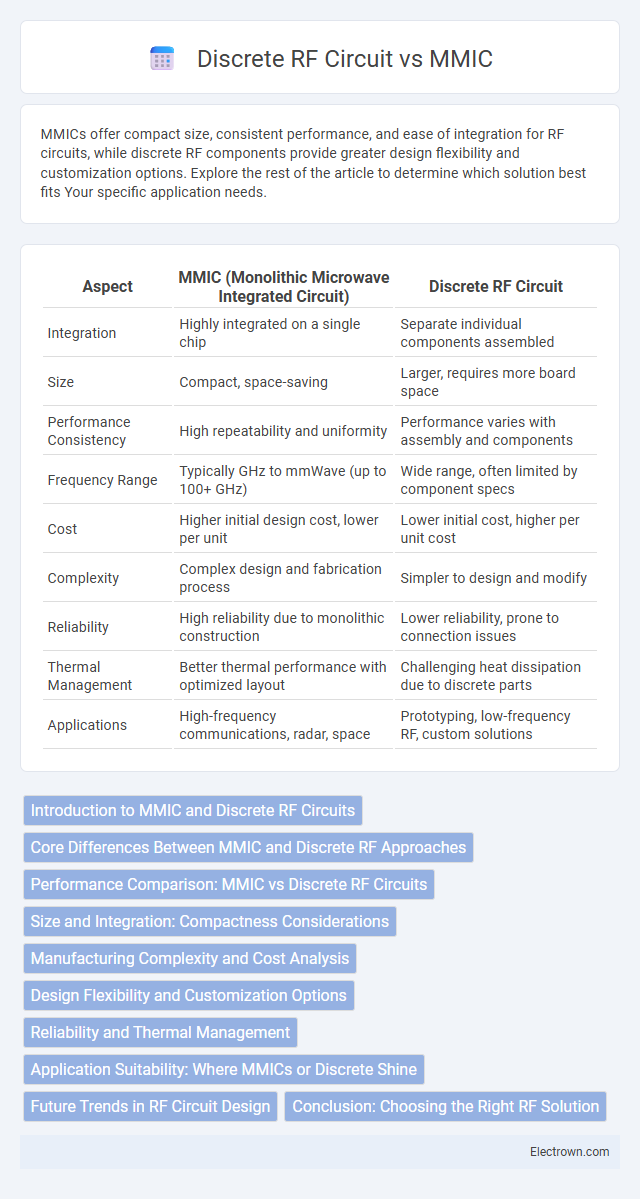MMICs offer compact size, consistent performance, and ease of integration for RF circuits, while discrete RF components provide greater design flexibility and customization options. Explore the rest of the article to determine which solution best fits Your specific application needs.
Table of Comparison
| Aspect | MMIC (Monolithic Microwave Integrated Circuit) | Discrete RF Circuit |
|---|---|---|
| Integration | Highly integrated on a single chip | Separate individual components assembled |
| Size | Compact, space-saving | Larger, requires more board space |
| Performance Consistency | High repeatability and uniformity | Performance varies with assembly and components |
| Frequency Range | Typically GHz to mmWave (up to 100+ GHz) | Wide range, often limited by component specs |
| Cost | Higher initial design cost, lower per unit | Lower initial cost, higher per unit cost |
| Complexity | Complex design and fabrication process | Simpler to design and modify |
| Reliability | High reliability due to monolithic construction | Lower reliability, prone to connection issues |
| Thermal Management | Better thermal performance with optimized layout | Challenging heat dissipation due to discrete parts |
| Applications | High-frequency communications, radar, space | Prototyping, low-frequency RF, custom solutions |
Introduction to MMIC and Discrete RF Circuits
MMICs (Monolithic Microwave Integrated Circuits) integrate multiple RF components on a single semiconductor chip, enabling compact size and high-frequency performance up to millimeter-wave bands. Discrete RF circuits consist of individual components like transistors, capacitors, and inductors assembled on a PCB, offering flexibility in design and easier customization for specific applications. Your choice between MMIC and discrete RF circuits influences factors such as size, frequency range, power handling, and manufacturing complexity in RF system design.
Core Differences Between MMIC and Discrete RF Approaches
MMICs (Monolithic Microwave Integrated Circuits) integrate multiple RF functions onto a single semiconductor chip, offering compact size, consistency, and high-frequency performance suitable for mass production. Discrete RF circuits, composed of individual components like transistors, capacitors, and inductors, provide greater design flexibility and easier customization but often result in larger size and variation in performance. Your choice depends on priorities such as integration level, frequency range, power handling, and manufacturing volume.
Performance Comparison: MMIC vs Discrete RF Circuits
Monolithic Microwave Integrated Circuits (MMICs) offer superior performance consistency and reduced parasitic effects compared to discrete RF circuits, enhancing high-frequency signal integrity and minimizing noise. Discrete RF circuits provide greater flexibility for custom component selection and tuning, often resulting in improved power handling and thermal management. MMICs excel in integration density and repeatability, making them ideal for compact, high-volume applications, while discrete circuits are preferred for tailored designs requiring specific performance optimizations.
Size and Integration: Compactness Considerations
MMICs (Monolithic Microwave Integrated Circuits) offer significantly smaller size and higher integration density compared to discrete RF circuits, enabling more compact and lightweight designs. By integrating multiple RF components such as amplifiers, mixers, and filters on a single semiconductor substrate, MMICs reduce the need for bulky interconnections and minimize parasitic losses. Your wireless system benefits from improved performance and reduced footprint, crucial for space-constrained applications like mobile devices and aerospace systems.
Manufacturing Complexity and Cost Analysis
MMICs (Monolithic Microwave Integrated Circuits) offer reduced manufacturing complexity by integrating multiple RF components on a single semiconductor substrate, lowering assembly time and minimizing variation during production. Discrete RF circuits require separate components and complex interconnections, increasing labor costs and risk of performance inconsistency. Your choice between MMIC and discrete RF designs should consider initial tool investment versus long-term cost efficiency and scalability in high-volume manufacturing.
Design Flexibility and Customization Options
MMICs offer limited design flexibility due to their fixed integrated architecture, making them ideal for mass-produced, standardized applications. Discrete RF circuits provide extensive customization options, allowing you to tailor each component's performance to meet specific system requirements and optimize overall functionality. Engineers often prefer discrete designs when unique impedance matching, gain control, or frequency tuning are critical to the application.
Reliability and Thermal Management
MMICs (Monolithic Microwave Integrated Circuits) offer superior reliability due to their compact, monolithic construction, minimizing interconnect failures common in discrete RF circuits. Thermal management is more efficient in MMICs because their integrated design facilitates uniform heat dissipation, reducing hotspots that can impair performance or cause failure. Your choice between MMIC and discrete RF circuits significantly impacts device durability and thermal stability in high-frequency applications.
Application Suitability: Where MMICs or Discrete Shine
MMICs excel in high-frequency applications requiring compact size, low parasitic effects, and consistent performance, making them ideal for satellite communications, radar systems, and mobile devices. Discrete RF circuits are better suited for customized, low-frequency designs where flexibility in component selection and thermal management is critical, such as in test equipment or low-volume production. Understanding your application's frequency, size, and performance demands helps determine whether an MMIC or discrete RF circuit provides the best solution.
Future Trends in RF Circuit Design
Future trends in RF circuit design highlight a shift toward MMIC technology due to its superior integration, miniaturization, and enhanced performance at high frequencies compared to discrete RF circuits. Advances in semiconductor materials like GaN and SiGe enable MMICs to achieve higher power efficiency and greater linearity, meeting the demands of 5G, IoT, and beyond. Your choice between MMIC and discrete solutions will increasingly depend on the need for scalability, cost efficiency, and the complexity of integration in next-generation wireless applications.
Conclusion: Choosing the Right RF Solution
MMICs offer compact size, consistent performance, and ease of integration, making them ideal for high-frequency applications requiring reliability and minimal footprint. Discrete RF circuits provide greater design flexibility and customization, suitable for specialized applications demanding tailored performance and scalability. Selecting the right RF solution depends on factors like frequency range, power requirements, integration complexity, and cost constraints, ensuring optimal performance and system efficiency.
MMIC vs discrete RF circuit Infographic

 electrown.com
electrown.com